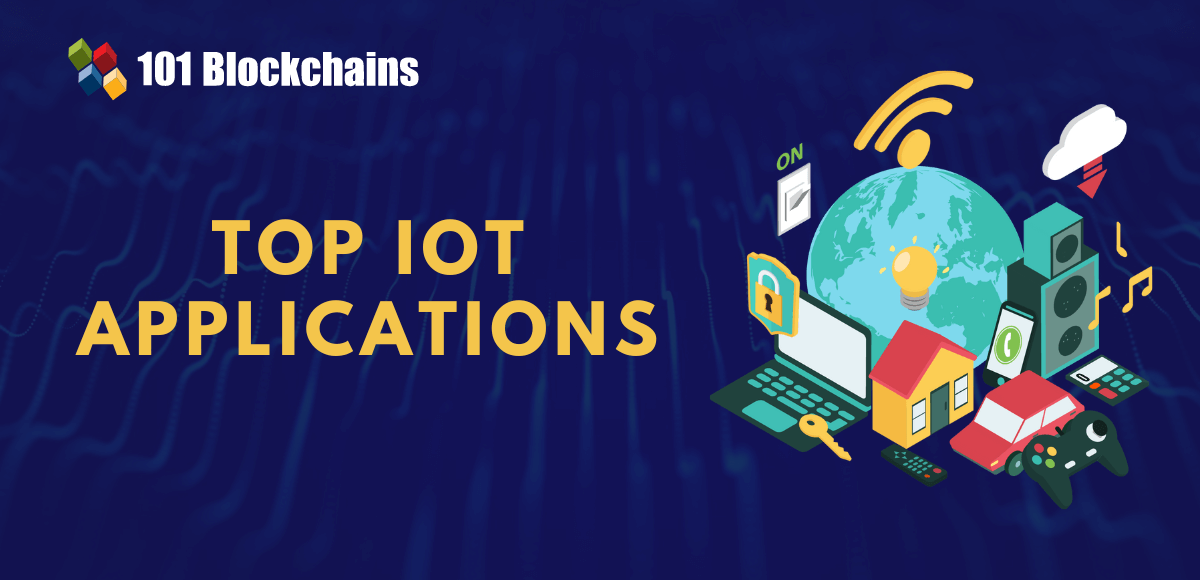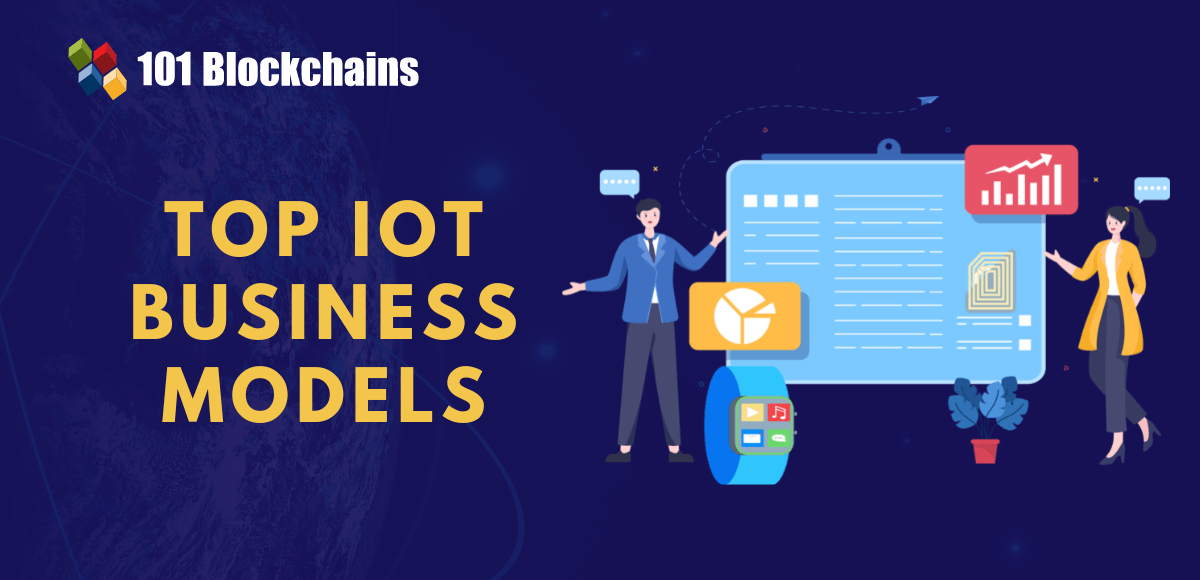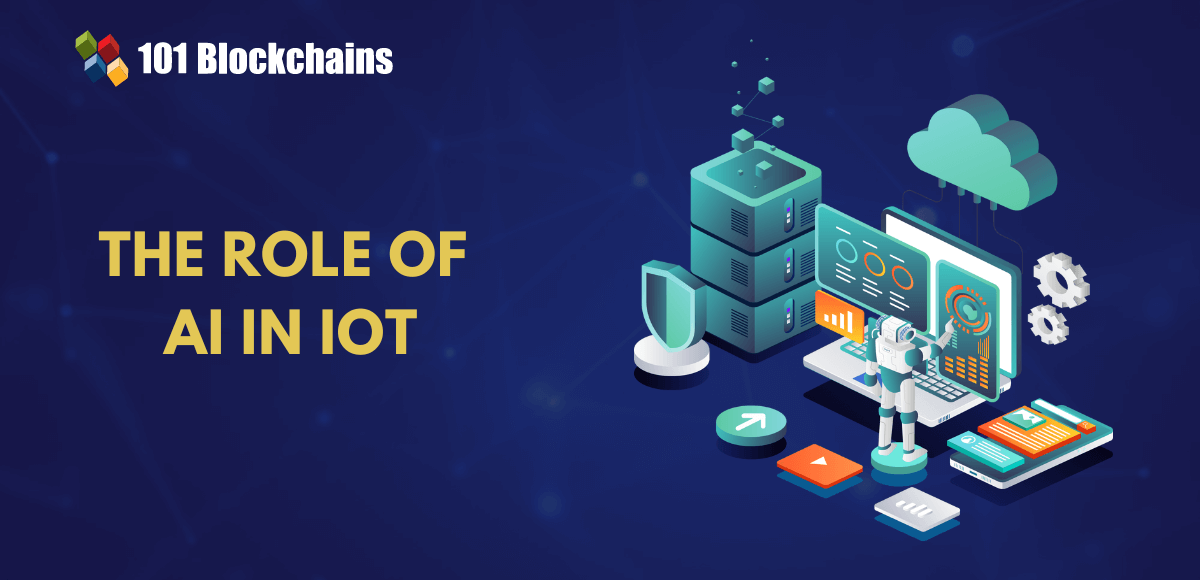Learn how blockchain truly works, master key definitions, and uncover what makes smart contracts so "smart." Dive into the fundamentals, gain valuable insights, and start your blockchain journey today!
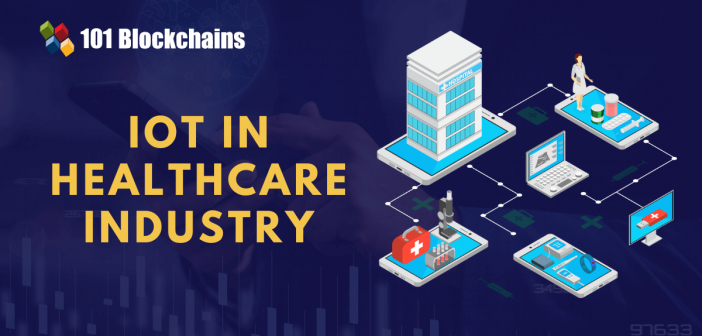
- IoT
James Howell
- on July 24, 2023
What is the use of IoT in the healthcare industry?
The advantages of IoT applications in healthcare have pointed out the possibilities for a new era of transformation. For example, the use of IoT in healthcare has enabled the prospects for remote patient monitoring. As a result, doctors could discover new avenues for delivering better healthcare services alongside safeguarding patient health and safety through continuous monitoring.
IoT has also proved useful in increasing patient satisfaction and engagement through easier and more efficient interactions with healthcare professionals. Remote monitoring of patients could also provide effective solutions for reducing the duration of patients staying in the hospital. At the same time, the use of IoT in healthcare can also support a significant reduction in healthcare costs alongside ensuring better treatment results. The advantages of IoT for healthcare services as one of the prominent reasons to learn about application of IoT in healthcare.
IoT ensures the benefits of improved interconnectivity among medical devices, obtaining insights from IoT data for better medical decisions and streamlined delivery of healthcare services. The following post offers you comprehensive insights into the applications of IoT for healthcare.
How Does IoT Transform Healthcare?
Before you find out the list of IoT applications in healthcare, it is important to understand the impact of IoT on healthcare. How does the use of IoT in the healthcare industry induce transformative changes? Interestingly, Internet of Things provides seamless connectivity in digital healthcare applications, which improves user experience. The global internet of medical things or IoMT market could reach a market capitalization of almost $187.6 billion by 2028.
In addition, the answers to “What are some facts about IoT in healthcare?” would also point to the staggering growth of remote patient monitoring. Predictions suggest that the number of remote patient monitoring or RPM users in the US will reach almost 70.6 million by 2025. As a matter of fact, the global market for RPM systems would have a market capitalization exceeding $1.7 trillion by 2027.
The statistics about impact of IoT in healthcare show the scale of transformation IoT introduces in healthcare. At the same time, it is also important to learn about the ways in which Internet of Things helps different participants in the healthcare ecosystem. Here is an outline of the different ways in which IoT changes healthcare for patients, physicians, insurance companies and healthcare providers.
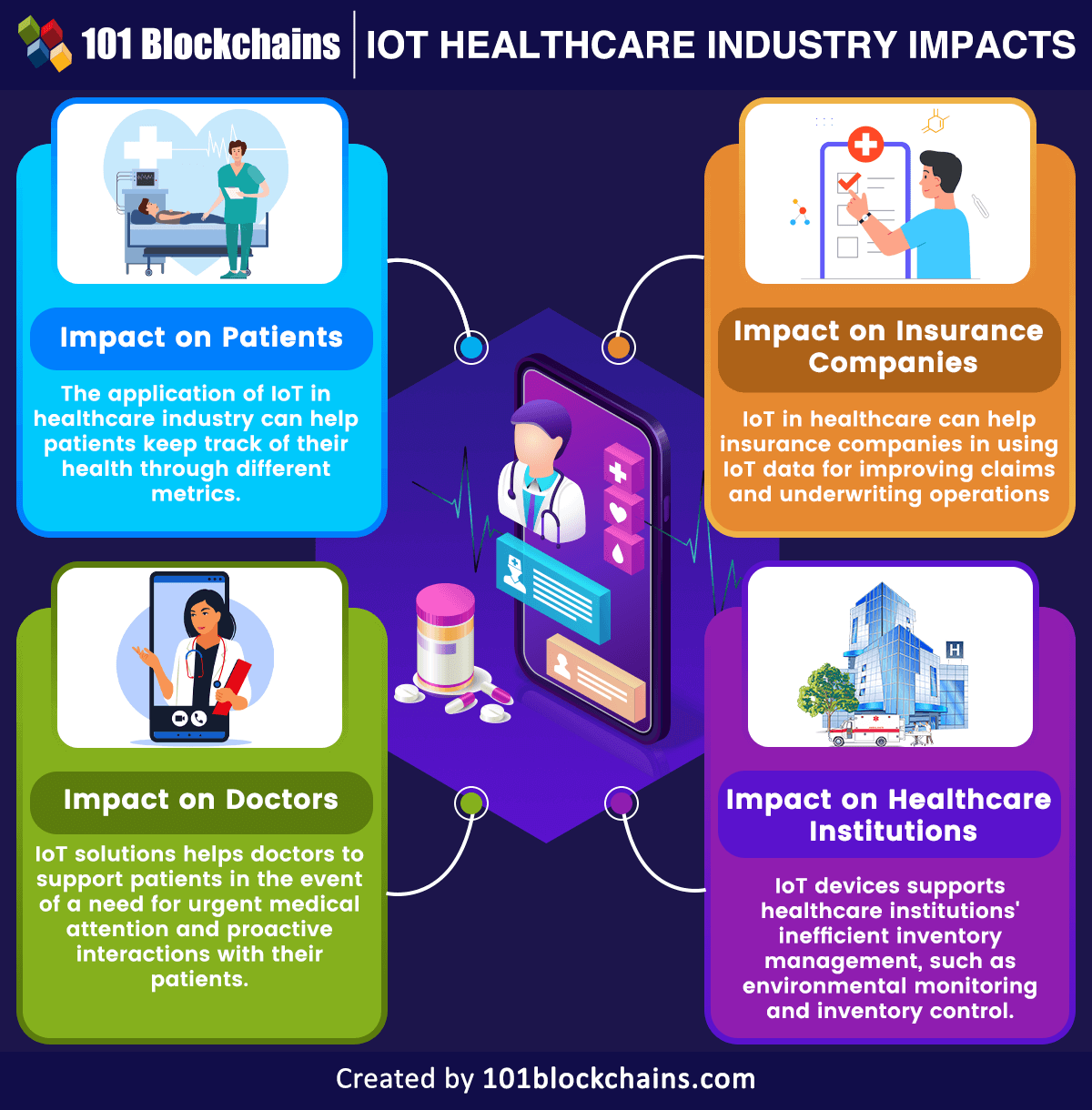
-
Impact on Patients
The effect of IoT on healthcare for patients is visible in the adoption of IoT devices. Access to IoT devices such as wearables, such as fitness bands and heart rate monitors or glucometers can help patients personalize their healthcare routine. The application of IoT in healthcare industry can help patients keep track of their health through different metrics. Some of the important metrics adopted by patients include calorie count, blood pressure fluctuation, medical appointments and exercise checks.
-
Impact on Doctors
The influence of IoT in healthcare also encompasses value benefits for doctors. For example, remote patient monitoring can help doctors in tracking patient health with better accuracy and efficiency. In addition, the benefits of IoT in healthcare for doctors also help in checking whether patients follow recommended treatment plans.
IoT solutions can also help doctors support patients in the event of a need for urgent medical attention. Internet of Things can also help doctors with more proactive interactions with their patients. On top of it, the data obtained from IoT devices could support doctors in figuring out the ideal treatment processes.
Want to understand the fundamentals of the Internet of Things (IoT)? Enroll now in IoT Fundamentals Course
-
Impact on Healthcare Institutions
The study of IoT’s effects on healthcare would invite the necessity for learning about how IoT affects healthcare institutions and service providers. For example, the use of IoT for asset monitoring can help hospitals in tracking the real-time location of healthcare equipment. Furthermore, IoT-based systems could help in real-time analysis of the deployment of medical staff at multiple locations. IoT devices can also support healthcare institutions’ inefficient inventory management, such as environmental monitoring and inventory control.
-
Impact on Insurance Companies
The overview of how IoT affects healthcare industry would also draw the limelight on insurance companies. The use of IoT in healthcare can help insurance companies in using IoT data for improving claims and underwriting operations. Effective analysis of IoT data could help in detecting fraud claims alongside improving transparency between customers and insurers.
Expand your knowledge of IoT with comprehensive IoT Flashcards explaining terms and technologies,
Most Popular Applications of IoT in Healthcare
The transformative impact of IoT in healthcare creates curiosity regarding the existing applications of IoT for healthcare. Here are some of the most popular IoT-based applications which have been changing traditional processes and systems in healthcare.
-
Remote Patient Monitoring
The review of answers to “What are some facts about IoT in healthcare?” revealed how Remote Patient Monitoring or RPM services are expanding at a staggering pace. RPM systems are the most common IoT application in the domain of healthcare. IoT devices could ensure automatic collection of health metrics such as temperature, blood pressure, heart rate and other vital stats. The interesting thing about RPM systems is that patients do not have to visit a healthcare facility to collect important data about their health.
After collecting patient data, the IoT device sends the data to an application where patients or doctors can see it. Subsequently, such applications of IoT in healthcare industry also use algorithms that can analyze the IoT data for recommended personalized treatment plans or alerts. For example, IoT sensors can detect irregular inpatient heart rates and send alerts to healthcare professionals for intervention.
-
Heart-Rate Monitoring
Continuing with the example mentioned for Remote Patient Monitoring applications of IoT, you can also consider heart-rate monitoring devices as another example of IoT in healthcare. Understanding ‘what is IoT in healthcare’ could help you understand how IoT can play a crucial role in avoiding cardiac health problems. Frequent heart rate tests at regular intervals do not provide an impression of fluctuations in heart rate. On the other hand, traditional devices used for monitoring heart rate at hospitals have complex setup which restricts mobility.
As of now, you can access a variety of IoT devices for heart rate monitoring. The devices help patients move around freely while ensuring consistent monitoring of their heart rates. On top of it, the assurance of accurate rates of over 90% in IoT-based heart rate monitors also guarantees promising healthcare benefits.
Want to familiarize yourself with the technology stack associated with IoT? Enroll now in Internet Of Things (IoT) – Intermediate Level Course
-
Glucose Monitoring
Diabetes is one of the biggest chronic health conditions affecting millions of people worldwide. In the US alone, 30 million diabetes patients struggle with glucose monitoring. Regular checking of glucose levels alongside a manual recording of results could help in detecting anomalies.
Interestingly, the use of IoT in the healthcare industry has enabled devices for continuous and automatic monitoring of glucose levels. Glucose monitoring devices reduce the necessity of maintaining manual records and could provide timely alerts for problematic glucose level indications.
-
Mood Monitoring Devices
Safeguarding mental health has emerged as one of the top priorities in healthcare recently. On the other hand, difficulties in collecting data about symptoms of depression of general mood variations of patients create challenges for mental health improvements. Healthcare providers could ask patients about their feelings, albeit without any scope for predicting abrupt mood swings.
Reflecting on answers to “What are some facts about IoT in healthcare?” would help you find information about the use of ‘mood-aware’ IoT devices. The IoT devices for monitoring the mood of an individual measure blood pressure and heart rate. The devices would then use the information about heart rate and blood pressure to come up with conclusions about the mental state of an individual.
Interestingly, advanced IoT devices for facilitating mood monitoring could help in tracking data such as eye movements of the patient. However, mood monitoring devices are still in the nascent stages of development and cannot provide accurate alerts about depression.
Learn the latest insights about the IoT (Internet of Things) and understand how it’s related to the blockchain with industry experts with IoT Skill Path
Innovative Applications of IoT in Healthcare
The detailed impression of “what is IoT in healthcare” and its applications would also include details of innovative IoT applications. Some of the potential IoT applications in healthcare which could change the future of healthcare include,
-
Ingestible Sensors
Ingestible sensors are a revolutionary IoT application in healthcare for collecting data from digestive and other organ systems. Such types of sensors could offer insights into stomach pH levels and are easy to pass through the human body.
-
Robotic Surgery
Robotic-aided surgical procedures have emerged as one of the striking highlights in the healthcare industry. Imagine the impact of IoT in healthcare sector with the introduction of IoT-enabled robots capable of surgery. Small IoT-connected robots could help in performing complex surgical procedures with minimally invasive processes, which ensures faster healing.
Curious to know how the IoT business mechanisms work? Enroll now in the Internet Of Things Business Impact Course
Examples of IoT Applications in Healthcare
The different types of applications of IoT for the healthcare sector showcase impressive potential. How can you evaluate the real potential of IoT for transforming the healthcare sector? You can find a better impression of the benefits of IoT in healthcare by reviewing the details of real-world examples. Here are some of the popular real-world examples of the applications of IoT for healthcare.
- ZOLL Medical Corporation has come up with an IoT-enabled cardiac monitor which helps maintain seamless connection between patients and healthcare providers.
- The heart rate monitoring devices by AliveCor, such as the EKG device, help in detecting different types of arrhythmias.
- Nexleaf Analytics has invested in IoT technology to improve conditions for cooking and vaccinations in less developed countries. The ColdTrace system by Nexleaf helps in remote temperature monitoring for vaccine refrigerators in rural health facilities and clinics.
- The examples for use of IoT in healthcare would also focus on a leading pharmaceutical giant, Pfizer. It has adopted IoT in different areas, particularly with the collaboration with IBM for supporting immuno-oncology research. In addition, Pfizer has also deployed IoT technology to support the development and distribution of COVID-19 vaccines.
- Aeris Communications has developed an IoT-based platform to support healthcare providers and medical device manufacturers in interacting with patients. The IoT platform helps in ensuring that patients follow recommended medical advice, such as medication frequency and dosage.
- The Genesis Touch application by Honeywell is another example of how uses of IoT for healthcare can create revolutionary outcomes. Genesis Touch platform helps patients connect with remotely located healthcare professionals. The platform helps healthcare providers access biometrics data of patients through a dashboard.
Learn the latest insights about the IoT (Internet of Things) and understand how it’s related to the blockchain with industry experts with IoT Skill Path
Conclusion
The detailed response to “What are some facts about IoT in healthcare?” alongside the influence of IoT on healthcare showcases the significance of IoT. Internet of Things not only introduces connectivity but also supports many other functionalities for reforming healthcare services.
IoT can introduce new and efficient approaches for patients, doctors and healthcare organizations to make the most of healthcare services. The understanding of ‘what is IoT in healthcare’ would vary according to different perspectives of patients and healthcare providers. Ultimately, IoT serves groundbreaking improvements in quality of care and cost reduction alongside improving patient experiences.
At the same time, healthcare providers can ensure efficient allocation and utilization of resources. Similarly, doctors could find streamlined approaches for delivering healthcare services personalized to the needs of each patient. Learn more about IoT and its applications in the real world right now.




